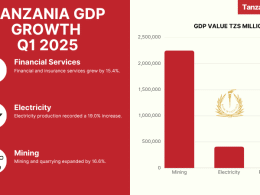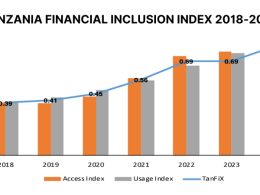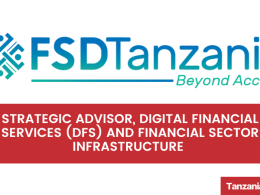The Tanzania Financial Stability Report 2022 recently released by the central bank (BOT) indicates that the country’s financial system remains resilient despite facing risks from the global economy.
According to the report, Tanzania’s GDP growth is estimated at 4.7% for 2022 and is projected to reach 5.2% in 2023 for Mainland Tanzania.
The growth forecast reflects increased infrastructure investment by the government and recovery in private sector activity.
Zanzibar’s GDP grew by 6.8% in 2022 and is projected to reach 7.1% in 2023.
The report notes that globally, growth is estimated at 3.4% in 2022 and is projected to slow further to 2.9% in 2023 by IMF estimates.
Tighter financial conditions, high inflation, the war in Ukraine, and COVID-19 disruptions continue to threaten the global economy.
These external risks may impact Tanzania through increased costs of imports, debt servicing pressures, and exchange rate volatility.
However, accommodative monetary policy, prudent fiscal measures, and regulatory interventions by BOT and the government have supported the resilience of Tanzania’s financial system thus far.
Financial Sector Performances
The financial sector performance remained robust, as attested by the growth of assets.
The financial sector assets grew by 17.2% in 2022 compared to 13.7% in 2021, dominated by banks with 70.4% and pension funds with 25.6%.
The financial sector’s total assets as a percentage of GDP increased to 40.7% in 2022 from 34.7% in 2021.
The growth was partly attributed to increased lending to the private sector, improvement in business conditions, and a pick up of domestic growth trajectory.
The financial sector remained resilient to shocks amid challenges experienced by the war in Ukraine and global inflationary pressures.
In 2022, the resilience of the sector was reinforced by measures undertaken by the Government and BOT to limit the effects of the war in Ukraine and global inflationary pressures, such as accommodative monetary policy, fiscal measures as well as supervisory and regulatory interventions to ensure sustainability and the stability of the sector.
The resilience was also observed in non-bank financial institutions, which comprises social security, insurance, and capital market, while financial system infrastructure continued to maintain efficiency through smooth operations for ensuring safety and reliability in payments hence enhancing financial stability and growth in the country.
Commenting on the overall performances of the financial sector, BOT Governor Emmanuel Tutuba stresses in his foreword that “the Tanzanian financial system remained strong, well placed to support the economy, and the outlook remains positive. Together with other Tanzania Financial Stability Forum members, the Bank is closely monitoring any adverse effects on the broader financial system. Financial institutions must continue to invest in their capacity to absorb shocks by maintaining strong capital and liquidity buffers and increasing their operational resilience, including external threats like cyber-attacks.”
Banking Sector Performances
The banking sub-sector remained resilient with adequate capital, liquidity, and subdued credit risks. The regulatory capital and liquidity ratios remained above the minimum requirements, despite a slight decline following the disbursement of new loans.
This is reflected by increased lending to the private sector, which grew by 22.5% due to a pick-up in business activities and policy and regulatory measures taken by the Bank and Government.
Further, credit risk declined, with NPL ratios dropping to 5.7%, mainly due to intensified credit recovery efforts, enhanced credit underwriting standards, and improved borrowers’ debt servicing capacity resulting in to increase in profitability.
“The increase in profitability in the sub-sector will further improve the resilience of the banking subsector to withstand potential shocks,” the report estimates.
Insurance Sector Performances
The insurance sub-sector remained sound, as depicted by the gross premium and profitability increase, coupled with adequate capital and liquidity.
The Gross Premium Written (GPW) increased by 25.9% in 2022, mainly due to post-pandemic business rebound related to transport, tourism, accommodation, and aggressive marketing by insurance companies and other insurance registrants.
The growth was further supported by post-pandemic business rebound related to transport, tourism, accommodation, and increased marketing.
Capital Markets Performances
The capital markets sub-sector remained sound and resilient, with increased participation of domestic investors both in the buy and sell sides.
Trading activities in equity and bond markets rose during the year ended December 2022 by 21.8%. Also, Net Asset Value (NAV) of Collective Investment Schemes increased significantly by 65.3%.
Social Security Performances
The social security sub-sector was resilient, with improved assets and the ability to meet maturing obligations.
At the end of December 2022, total assets grew by 7.2% while the total Return on Investment increased by 22.0% compared to December 2021.
Funds increased investment in fixed deposits and government securities relative to other investments mainly due to increased returns and lower risk.
Financial Stability Outlook
The report concludes that near-term risks to Tanzania’s financial stability are assessed to be moderate, but could heighten if global headwinds worsen and Tutuba stresses that BOT remains committed to maintaining stability through appropriate policies and reforms.
Within such a framework, the growth of the domestic economy is expected to remain stable amid the analyzed potential shocks.
The economy is projected to grow at 5.2% and 7.1% in 2023 for Mainland Tanzania and Zanzibar, respectively.
The positive outlook is supported by improvements in business conditions, profitability, adequate capital to fund businesses, and public investment in infrastructure.










